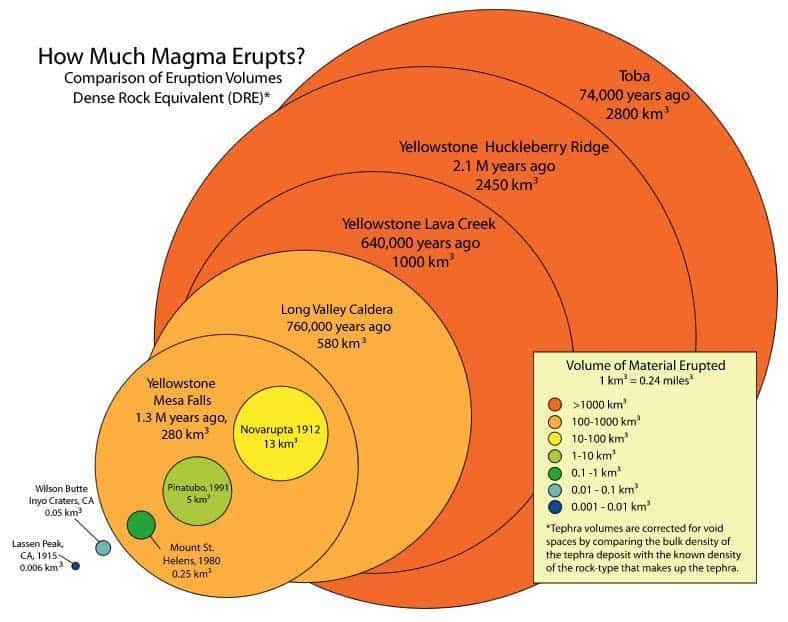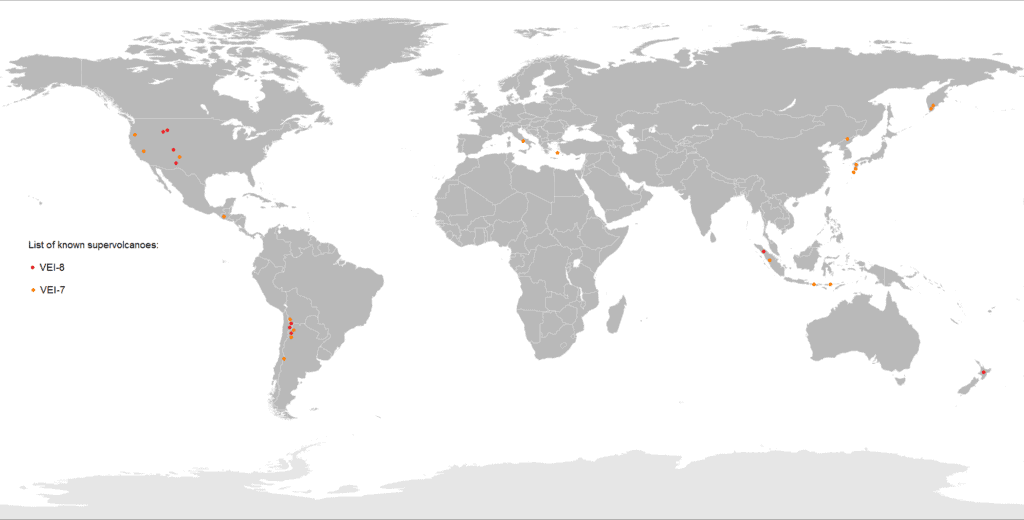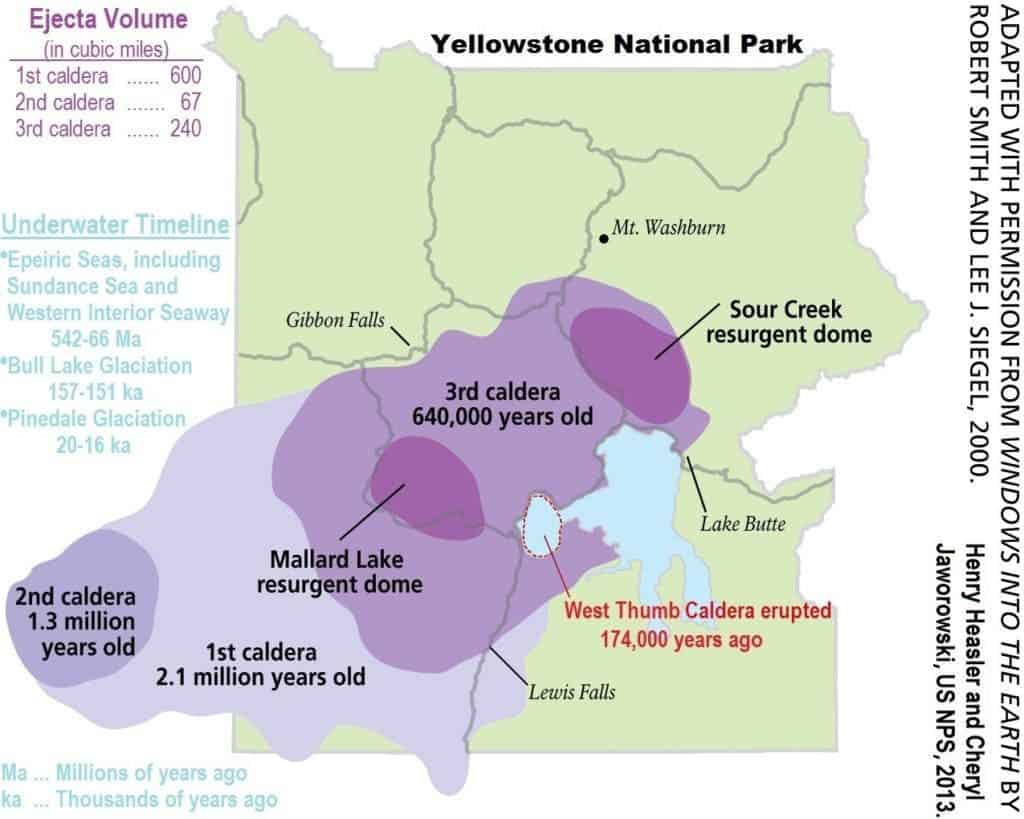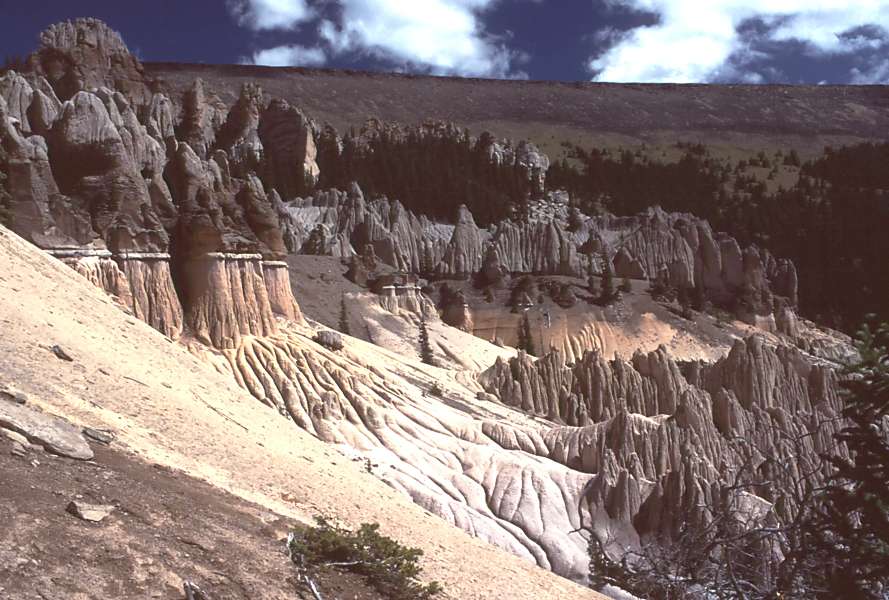As the name implies, a supervolcano is an extremely large volcano, capable of ejecting over 1,000 cubic kilometers (240 cubic miles) of deposits. There are six known supervolcanoes and twelve known super-eruptions.

What is a supervolcano
If we want to see what makes a supervolcano, we need to first understand what a volcano is — and what makes it ‘super’.
The Earth’s internal structure is layered in three spherical shells: an outer solid crust (everything we see and walk on), a viscous mantle, an outer core that is much less viscous than the mantle (often considered liquid), and a solid inner core. A volcano is a rupture in the crust that allows material from the asthenosphere to reach the surface in the form of lava, volcanic ash, and gases.
You can think of volcanoes as vents through which molten rock escapes to the surface.
Most volcanoes appear because the Earth’s crust is fractured into rigid plates called tectonic plates. These plates “float” on a hotter, softer layer in its mantle. When pressure from gases within the molten rock becomes too great, an eruption occurs, but in order for this to happen, a volcano must first gather magma in a magma chamber.
A magma chamber is like a cauldron of molten rock, put under great pressure, that gradually fractures the other rocks around it, as it tries to reach the surface in order to release its pressure. These magma chambers lie deep inside the earth, generally at around 1-10 km deep.

When an eruption takes place and material is ejected from the magma chambers, they sometimes form features called calderas: large circular or oval depressions, more than 1 km (0.6 miles) in diameter. Calderas appear because the magma was supporting the weight above it, and when the magma is ejected through the volcano, the whole thing can collapse under its own weight. For this reason, calderas can somewhat resemble craters.
But sometimes, the magma can’t push through to the surface, so it gathers in the magma chamber, building up the pressure. As the magma pool gets bigger and bigger, the chamber grows, reaching ungodly pressures — and when it does it erupt, it’s an enormous eruption; you could say, a super-eruption.
That’s right: supervolcanoes form when they gather enough magma and pressure for a gargantuan explosion. In more formal terms, geologists classify supervolcanoes as having a “VEI” of 8. The Volcanic Explosivity Index (VEI) is a relative measure of the explosiveness of volcanic eruptions, devised by researchers from the United States Geological Survey. The largest possible VEI magnitude is 8 — so, in other words, a supervolcano is the largest possible volcano.

[panel style=”panel-info” title=”Studying volcanoes” footer=””]Geologists are even able to study even extremely old eruptions, from tens of millions of years ago. Supervolcano eruptions send ejecta all across the world and release tremendous quantities of deposits — a thick layer around the volcano which thins out the farther away from the volcano it spreads. These deposits can be dated and analyzed physically and chemically, revealing a lot of information about the initial eruption.[/panel]
What are the supervolcanoes?
Thankfully, there aren’t that many supervolcanoes on Earth. It’s not entirely clear just how many super-eruptions there have been in Earth’s history (we’ll use that term even though it’s not quite proper). Some research has found evidence of 60 super-eruptions, while other studies report 47 such events, with the most recent one being the Oruanui eruption of New Zealand’s Taupo Volcano, 26,500 years ago. The Oruanui eruption was a highly unusual one, with a complex interplay of ejection and pyroclastic flows, covering New Zealand’s North Island with ignimbrite (a type of hardened tuff) up to 200 meters (660 ft) deep. The same volcanic area caused two other super-eruptions, 340,000 and 1,080,000 years ago respectively.
Another famous eruption is Lake Toba, which occurred some 74,000 years ago (it’s rather unusual to have two super eruptions in such quick geological succession). The eruption of Toba led to a volcanic winter (a drop in global temperatures caused by volcanic ash and droplets of sulfuric acid and water which obscure the Sun) with a worldwide decrease in temperature between 3 to 5 °C (5.4 to 9.0 °F), and up to 15 °C (27 °F) in higher latitudes. This had catastrophic consequences for the planet’s wildlife — including early humans. It killed most of the humans living at the time, creating a population bottleneck in central east Africa and India, which affects the genetic makeup of the human worldwide population to this day.

However, without a doubt, the most famous supervolcano is Yellowstone.
The Yellowstone supervolcano
Unlike most volcanoes, which emerge at the boundary of tectonic plates, Yellowstone (in Idaho, US) is a hotspot. Hotspots are pockets of unusually hot magma. It is thought that these hotspots are fed by the underlying mantle. Intriguingly, their position is not influenced by plate tectonics — as the plates move, the hotspot stays in the same place, because it lies beneath the crust. This can create a so-called hotspot trail, which leads to the illusion that the hotspot is moving — it is, in fact, the surface of the Earth that is moving above the hotspot. There is a lot of scientific debate around the nature and development of hotspots, but let’s get back to Yellowstone, shall we?
Remember how we said hotspots can leave a trail behind them? That’s exactly what the Yellowstone hotspot did. So it has not one, but several calderas (including the Island Park Caldera, the Henry’s Fork Caldera, and the Bruneau-Jarbidge caldera). The current hotspot lies beneath the Yellowstone Caldera.

The largest eruption at Yellowstone took place 2.1 million years ago and had a volume of 2,450 cubic kilometers. However, it had several smaller eruptions. Volcanism at Yellowstone seems to happen periodically — there was an eruption 1.3 million years ago, and another one approximately 630,000 years ago. Much smaller eruptions (not super-eruptions) have happened as early as 2,270 years ago.
[panel style=”panel-info” title=”What would happen if Yellowstone were to erupt” footer=””]A super-eruption of Yellowstone would have catastrophic consequences. The eruption itself (the local lava and ejected rocks) would pale in comparison to what would happen on a wider scale. First, it could bury states like Wyoming, Montana, Idaho, and Colorado in three feet of volcanic ash, killing plants, animals, and insects alike. Electrical systems would be destroyed, houses would be crushed, and much of the US would be gravely damaged.
But perhaps even worse, the ash would spread like a cover around the world, shrouding the Earth and reflecting sunlight back, creating a volcanic winter. Temperatures could drop by several degrees, crops would fail, and famine will likely spread all around the world. This situation would last for several years, before finally returning to normal.
Thankfully, that’s extremely unlikely to happen.[/panel]

Should we worry?
Not really. Studies have found that super-eruptions are extremely rare — on the basis of volcanic activity during the past 13.5 million years — there’s a 1% chance of an eruption of this scale in the next 460–7,200 years. Statistically, there are about 1.4 supervolcano eruptions every million years, so that would mean there is at least a 75% probability of a VEI 8 eruption in this timeframe.

So while these eruptions can be extremely damaging, they’re so rare that the time-averaged impact really isn’t that big. However, here’s the thing: VEI 7 eruptions occur much more frequently (10-100 times), so that means that on average, we should be more worried about these VEI 7 eruptions than the supervolcano eruptions.
[panel style=”panel-info” title=”The year without summer” footer=””]Mount Tambora had a VEI 7 eruption in 1815, which resulted in 1816 being called ‘The Year without Summer'[/panel]
Supervolcanoes are some of the most impressive features on our planet, capable of ungodly eruptions which would send the entire planet into disarray. But as it so often happens, it’s not the big sword that’s threatening, but the thousand smaller cuts.
Bonus: A super-super volcano
Interestingly, a 2004 study reports evidence of a VEI 9 eruption, responsible for the Fish Canyon Tuff.
Wait a minute — I thought you said VEI 8 was the maximum possible eruption?!
Well, yes, but scientists found evidence of an eruption with a mass of >1016 kg and a magnitude of 9.2. So while VEI 8 is technically the largest classification, the Fish Canyon Tuff eruption was more than 10 times larger what would be necessary to classify as a supervolcano.


